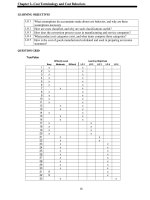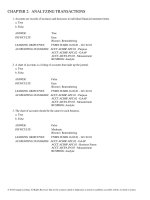Corporate finance accounting 14e by warren reeve duchac chapter 2
Bạn đang xem bản rút gọn của tài liệu. Xem và tải ngay bản đầy đủ của tài liệu tại đây (5.88 MB, 24 trang )
Chapter
2
Analyzing Transactions
Corporate
Financial
Accounting
14e
Warren
Reeve
Duchac
© 2017 Cengage Learning®. May not be scanned, copied or duplicated, or posted to a publicly accessible website, in whole or in part.
Using Accounts to Record Transactions
(slide 1 of 2)
•
Accounting systems are designed to show the
increases and decreases in each accounting
equation element as a separate record.
o
This record is called an account.
© 2017 Cengage Learning®. May not be scanned, copied or duplicated, or posted to a publicly accessible website, in whole or in part.
Using Accounts to Record Transactions
(slide 2 of 2)
•
A T account is a visual representation of an
account.
o
The left side of the account is called the debit side of
the account.
Increases in assets are recorded on the debit side.
o
The right side of the account is called the credit side
of the account.
Decreases in assets are recorded on the credit side.
© 2017 Cengage Learning®. May not be scanned, copied or duplicated, or posted to a publicly accessible website, in whole or in part.
The T Account
Cash
Debit
Side of
Account
(A)
(D)
Balance
25,000
7,500
5,900
(B)
(E)
(F)
(H)
20,000
3,650
950
2,000
Balance of the Account
(the excess of the debits
of an asset account over
its credits)
© 2017 Cengage Learning®. May not be scanned, copied or duplicated, or posted to a publicly accessible website, in whole or in part.
Credit
Side of
Account
Chart of Accounts
•
A group of accounts for a business entity is
called a ledger.
•
A list of the accounts in the ledger is called a
chart of accounts.
•
The accounts are normally listed in the order in
which they appear in the financial statements.
o
The balance sheet accounts are listed first, in the
order of assets, liabilities, and stockholders’ equity.
o
The income statement accounts are then listed in the
order of revenues and expenses.
© 2017 Cengage Learning®. May not be scanned, copied or duplicated, or posted to a publicly accessible website, in whole or in part.
Assets
•
Assets are resources owned by the business
entity.
© 2017 Cengage Learning®. May not be scanned, copied or duplicated, or posted to a publicly accessible website, in whole or in part.
Liabilities
•
Liabilities are debts owed to outsiders
(creditors).
© 2017 Cengage Learning®. May not be scanned, copied or duplicated, or posted to a publicly accessible website, in whole or in part.
Stockholders’ Equity
•
Stockholders’ equity is the stockholders’ right
to the assets of the business.
•
Stockholders’ equity is represented by the
balance of the common stock and retained
earnings accounts.
•
A dividends account represents distributions of
earnings to stockholders.
© 2017 Cengage Learning®. May not be scanned, copied or duplicated, or posted to a publicly accessible website, in whole or in part.
Revenues
•
Revenues are increases in assets and
stockholders’ equity as a result of selling
services or products to customers.
© 2017 Cengage Learning®. May not be scanned, copied or duplicated, or posted to a publicly accessible website, in whole or in part.
Expenses
•
Expenses result from using up assets or
consuming services in the process of generating
revenues.
© 2017 Cengage Learning®. May not be scanned, copied or duplicated, or posted to a publicly accessible website, in whole or in part.
Double-Entry Accounting System
•
All businesses use what is called the doubleentry accounting system.
•
This system is based on the accounting equation
and requires:
•
o
Every business transaction to be recorded in at least
two accounts.
o
The total debits recorded for each transaction to be
equal to the total credits recorded.
The double-entry accounting system has specific
rules of debit and credit for recording
transactions in the accounts.
© 2017 Cengage Learning®. May not be scanned, copied or duplicated, or posted to a publicly accessible website, in whole or in part.
Normal Balances
•
The sum of the increases in an account is
usually equal to or greater than the sum of the
decreases in the account. Thus, the normal
balance of an account is either a debit or credit
depending on whether increases in the account
are recorded as debits or credits.
© 2017 Cengage Learning®. May not be scanned, copied or duplicated, or posted to a publicly accessible website, in whole or in part.
Journalizing
(slide 1 of 3)
•
Using the rules of debit and credit, transactions
are initially entered in a record called a journal.
© 2017 Cengage Learning®. May not be scanned, copied or duplicated, or posted to a publicly accessible website, in whole or in part.
Journalizing
(slide 2 of 3)
•
Transactions are recorded in the journal using the following steps:
o
Step 1. The date of the transaction is entered in the Date column.
o
Step 2. The title of the account to be debited is recorded in the left-hand
margin under the Description column, and the amount to be debited is
entered in the Debit column.
o
Step 3. The title of the account to be credited is listed below and to the
right of the debited account title, and the amount to be credited is
entered in the Credit column.
o
Step 4. A brief description may be entered below the credited account.
o
Step 5. The Post. Ref. (Posting Reference) column is left blank when
the journal entry is initially recorded. This column is used later when the
journal entry amounts are transferred to the accounts in the ledger.
© 2017 Cengage Learning®. May not be scanned, copied or duplicated, or posted to a publicly accessible website, in whole or in part.
Journalizing
(slide 3 of 3)
•
The process of recording a transaction in the
journal is called journalizing.
•
The entry in the journal is called a journal entry.
© 2017 Cengage Learning®. May not be scanned, copied or duplicated, or posted to a publicly accessible website, in whole or in part.
Posting Journal Entries to Accounts
•
The process of transferring the debits and
credits from the journal entries to the accounts is
called posting.
© 2017 Cengage Learning®. May not be scanned, copied or duplicated, or posted to a publicly accessible website, in whole or in part.
Unearned Revenue
•
The liability created by receiving the cash in
advance of providing the service is called
unearned revenue.
© 2017 Cengage Learning®. May not be scanned, copied or duplicated, or posted to a publicly accessible website, in whole or in part.
Account Receivable
•
When a business agrees that a customer may
pay for services provided at a later date, an
account receivable is created.
o
An account receivable is a claim against the
customer.
o
An account receivable is an asset, and the revenue is
earned even though no cash has been received.
© 2017 Cengage Learning®. May not be scanned, copied or duplicated, or posted to a publicly accessible website, in whole or in part.
Trial Balance
(slide 1 of 3)
•
The equality of debits and credits in the ledger
should be proven at the end of each accounting
period by preparing a trial balance.
© 2017 Cengage Learning®. May not be scanned, copied or duplicated, or posted to a publicly accessible website, in whole or in part.
Trial Balance
(slide 2 of 3)
•
The steps in preparing a trial balance are as
follows:
o
Step 1. List the name of the company, the title of the
trial balance, and the date the trial balance is
prepared.
o
Step 2. List the accounts from the ledger, and enter
their debit or credit balance in the Debit or Credit
column of the trial balance.
o
Step 3. Total the Debit and Credit columns of the trial
balance.
o
Step 4. Verify that the total of the Debit column equals
the total of the Credit column.
© 2017 Cengage Learning®. May not be scanned, copied or duplicated, or posted to a publicly accessible website, in whole or in part.
Trial Balance
(slide 3 of 3)
•
An unadjusted trial balance is distinguished
from an adjusted trial balance and a post-closing
trial balance. (The latter two are prepared in later
chapters and include additional information.)
© 2017 Cengage Learning®. May not be scanned, copied or duplicated, or posted to a publicly accessible website, in whole or in part.
Errors Affecting the Trial Balance
•
A transposition occurs when the order of the
digits is copied incorrectly, such as writing $542
as $452 or $524.
•
In a slide, the entire number is copied
incorrectly one or more spaces to the right or the
left, such as writing $542.00 as $54.20 or
$5,420.00.
© 2017 Cengage Learning®. May not be scanned, copied or duplicated, or posted to a publicly accessible website, in whole or in part.
Errors Not Affecting the Trial Balance
•
Errors that do not cause the trial balance totals
to be unequal may be discovered when
preparing the trial balance or may be indicated
by an unusual account balance. For example,
since a business cannot have “negative”
supplies, a credit balance in the supplies
account indicates an error has occurred.
•
If an error has already been journalized and
posted to the ledger, a correcting journal entry
is normally prepared.
© 2017 Cengage Learning®. May not be scanned, copied or duplicated, or posted to a publicly accessible website, in whole or in part.
Analysis for Decision Making:
Horizontal Analysis
•
In horizontal analysis, the amount of each item
on a current financial statement is compared
with the same item on an earlier statement.
•
The increase or decrease in the amount of the
item is computed together with the percent of
increase or decrease.
•
When two statements are being compared, the
earlier statement is used as the base for
computing the amount and the percent of
change.
© 2017 Cengage Learning®. May not be scanned, copied or duplicated, or posted to a publicly accessible website, in whole or in part.









